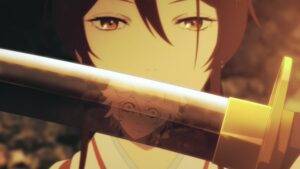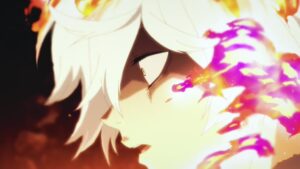Hell’s Paradise
Short Synopsis: Death row convict ninja is offered a chance at a full pardon if he finds the elixir of life with his hot would-be executioner.
Lenlo: For most of this first episode, Hell’s Paradise kind of disappointed me. Not narratively, that fits with what I expected. I liked how it spent an entire episode setting up Gabimaru’s personality, history, stakes in this conflict, as well as his relationship with Sagiri. All of that was fine, good time. No, what disappointed me was the production. For most of the episode it felt… lacking. There wasn’t that spark to it, something to set it apart, it felt passionless in a lot of ways and this was reflected in the rather drab color palette. But in the last maybe…1/3rd of the episode, Hell’s Paradise managed to bring it back. Its depiction of the island, of Gabimaru’s flames once he had his will to live back, of the flowers on the boat, all looked gorgeous. Maybe, just maybe, Hell’s Paradise is saving its production chops for the island, so that it truly feels set apart and otherworldly from the “real” mainland. At least that’s the hope I have as we head further into the season. If it can bring that production up a few steps, then I imagine I’ll have a good time with this.
Potential: 60%
Amun: Ah, this is actually really bad. I think with MAPPA’s recent success, we gloss over the less than stellar outings. Specifically, Hell’s Paradise feels a TON like the opening of Dororo, which…looked pretty good, but was a mess. I feel like the hype surrounding this show is an echo from Chainsaw Man’s success; I just have a bad feeling this show is the old MAPPA, not the new. Like Lenlo, I am very whelmed by the premiere – I think the characters are surprisingly uninteresting. Who knew, professional killers are kind of boring people – maybe it isn’t Gabimaru who is hollow, it’s Hell’s Paradise as a whole. Judging from previews and posters, this is an ensemble outing, so maybe some side characters help things along, but I don’t think I’ll last a season with these leads. It’s weird too, since I’m very partial to white haired heroes (Gabimaru is like an evil Bell), and Asaemon, on paper, is right in my strike zone. I guess maybe I’m not excited about the period piece that so far it looks to be – hopefully the island itself gets the series into the groove. As of right now, I’m very worried (plus there’s the infamous MAPPA back-half animation-quality crater).
Potential: Scared because I want this to be good (50%)
MIX SEASON 2
Short Synopsis: The key members of Meisei High consider new applicants and graduating middle school talents for a place on the school’s baseball team.
Wooper: Before booting up this premiere, I wondered whether Mix’s second season would feel significantly different from its 2019 incarnation, especially given the director change to first-timer Tomohiro Kamitani. Having seen the episode, the answer I’ve settled on is “only slightly,” which is a good thing, since I was fond of the series when it first aired. The presentation is largely the same, introducing characters with freeze frames and narration by Noriko Hidaka, who voiced Minami in Touch (Mix’s 40 year old prequel series). Poor background art and middling character animation are still the show’s greatest weaknesses, but it’s got the same strengths, as well: leisurely pacing that prioritizes fun dialogue between a wide range of established characters. The only new face in this whole episode was that of baseball team hopeful Nishiki, whose zombie-like appearance may be the result of mangaka Mitsuru Adachi trying to draw a new face for once in his career. Despite all the talk surrounding Nishiki’s violent past and shady friend group, I’m not too interested in him, or in any single character. Rather, it’s Mix’s overall blend of high school and graduating middle school students that appeals to me, laying the foundation for what ought to be a serious Koshien run in a couple years.
Potential: 60%
Mario: This first episode does a great job to remind us where the first season stopped (it has been a few years), and reintroduce the main cast with proper introduction cards to boost. But as usual with any of Adachi’s works, it’s less about baseball and more about the characters’ interaction, and so far its gentle atmosphere is a total delight. It looks like we will have a new addition to the team: the violent Nishiki. However, if you are familiar with Adachi’s brand, the “delinquent hit his senpais and got suspended” is a familiar trope, one I really hope Adachi doesn’t tread that same path this time. It’s great to have you back, Mix.
Potential: 40%
Tengoku Daimakyou
Short Synopsis: Fifteen years after an apocalyptic event, a pair of travelers search for an orphanage they know only by the name “Heaven.”
Lenlo: Tengoku is in a really weird place for me. The world is interesting, this Promised Neverland style setup where we get to see both sides of the wall/conflict is kinda cool, and the lead girl is pretty damn hot with those scars. But something about the pacing is just… I felt like this 20 minute episode took a god damn hour. I was constantly checking the time because it felt like it should be over. I don’t know why that is. By the end I was intrigued, there’s lots of cool stuff going on. It’s just that the presentation of it all feels… dull? I’m really not sure how to word it, but something about the show is failing to engage me. I’ve been told it is a blazing fast adaptation, that it isn’t a pacing issue. But I just can’t shake the feeling of something being off. Maybe it will change as I watch more, which I definitely want to do.
Potential: 50%
Wooper: Tengoku Daimakyou, or “Heavenly Delusion,” has met the majority of my high expectations after one episode. The art direction is uncommonly good, with climbing vines, rusted fences, and crumbling walls among the piles of evidence that Japan has been through a massive calamity in recent times. The script supports this idea by treating batteries as currency and focusing on resource conservation, along with supplying a loose timeframe of “the Collapse,” which seemingly predates the birth of the series’ two protagonists. Their exploration of this desolate Japan features a lot of proficient animation, as well – from major showcases like Maru’s martial arts expertise to small stuff like Kiru craning her neck to call for her partner, the level of motion on display in Tengoku Daimakyou is a cut above what you’d expect from an average TV anime. But all of these examples come from the show’s primary plot, which is set in the ruinous outside world; everything that happens within its idyllic orphanage (where Kiru and Maru are headed) has neither the intrigue nor visual appeal of what lies beyond its walls. Perhaps its role in the story will heat up if and when the kids start looking for an escape route, rather than just harboring suspicions or hearing directly from adults about the hellish conditions outside the orphanage. Until then, there are enough mysteries surrounding Tengoku’s primary duo to keep me coming back for more.
Potential: 70%






